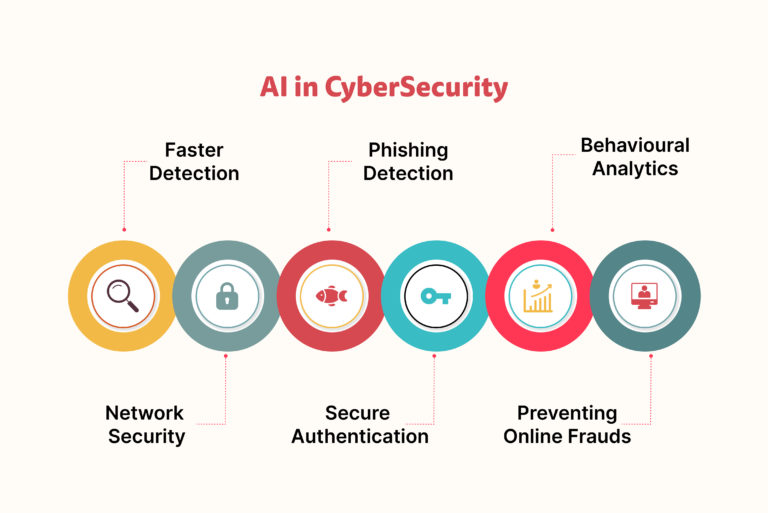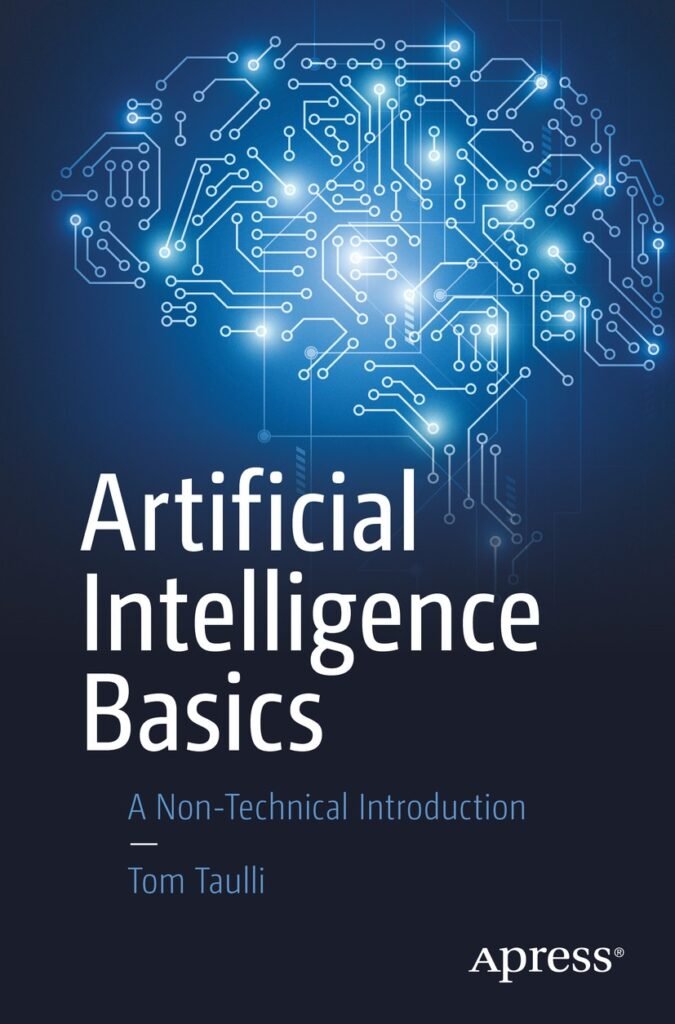AI powered cybersecurity can monitor, analyze detect, and respond to cyber threats in real time. As AI algorithms analyze massive amounts of data to detect patterns that are indicative of a cyber threat, it can also scan the entire network for weaknesses to prevent common kinds of cyber attacks.
AI primarily monitors and analyzes behavior patterns. Using these patterns to create a baseline, AI can detect unusual behaviors and restrict unauthorized access to systems. AI can also help to prioritize risk, instantly detect the possibility of malware and intrusions before they begin.
When implemented properly, AI can serve as the engine for security automation, which frees up the time and resources of employees by automating repetitive tasks. AI can also reduce the occurrence of human error by removing humans from a task or process.

How Is AI Cybersecurity Different?
Cybersecurity protection with artificial intelligence will never fully replace security professionals, as there will always be a need for creative problem-solving and more complex challenges in the workplace. However, AI can and already does assist human security professionals by analyzing vast amounts of data, recognizing patterns, and creating insights based on large volumes of security data. This could take hours, sometimes weeks to complete with traditional security processes.
Before AI, security professionals used signature-based detection tools and systems to identify potential cyber threats. These security tools compare incoming network traffic to a database of known threats or malicious code signatures. Upon detection, the system triggers an alert and suggests to the security professional that they should take an action to block or quarantine the threat.
This signature-based security approach has been reasonably effective against known threats. However, the signature-based detection approach has proven to be inadequate against new (Zero-Day) or unknown threats. Too often, these tools also resulted in a higher frequency of false positives, which sent security professionals on a “wild goose chase.”
Traditional cybersecurity also relies heavily on manual analysis. Security analysts must manually investigate security alerts and event logs in search of any identifiable patterns that serve as indicators of a potential security breach. Investigating logs and events can take extensive amounts of time and relying solely on a single security analyst is a mistake companies cannot afford to make.
AI has the power to address these shortcomings of traditional cybersecurity and much more. As this technology continues to mature, it will have a massive impact on cybersecurity processes and people.
Why Is AI in Cybersecurity Important?
Cyber criminal organizations have already invested in machine learning, automation, and AI to launch large-scale, targeted cyberattacks against organizations. The number of threats and potential for ransomware impacting networks continues to grow.
AI and machine learning is helping security analysts level the playing field by processing massive amounts of data, providing rapid insights based on analysis, and cutting through the noise of daily security alerts and false positives. This drastically improved your team’s efficiency and productivity, giving them an advantage over potential cyber criminals.
With the rise of more sophisticated attack vectors such as polymorphic malware, scripting, and so called “living-off-the-land” attacks, it has become easier for cybercriminals to bypass traditional, file-scanning-based anti-virus defenses. To protect against this evolution of malware, more modern approaches such as behavior analysis are becoming more popular in cybersecurity. Behavior analysis and detection approaches are powerful, as all malware eventually needs to exhibit malicious behavior in order to succeed. AI, when properly trained, has the capability to monitor, detect, and respond to these malicious behaviors faster than humans alone.
What Are the Benefits of AI in Cybersecurity?
Today’s AI systems are trained to detect potential cyber threats, identify new attack vectors, and safeguard your company’s sensitive data. The three top benefits to using AI driven cybersecurity tools include:
- Quickly analyzing large amounts of data
- Detecting anomalies and vulnerabilities
- Automating repetitive processes
The potential of leveraging AI in cybersecurity is virtually endless. The speed and accuracy of threat detection and response is as close to real-time as possible. AI can help minimize the impact of a ransomware attack by flagging suspicious behavior to your security team as soon as possible. And finally, AI makes cybersecurity operations more efficient through automation, freeing up your security team’s valuable time and resources to work on other, more important tasks.
Applying AI to cybersecurity
AI is ideally suited to solve some of our most difficult problems, and cybersecurity certainly falls into that category. With today’s ever evolving cyber-attacks and proliferation of devices, machine learning and AI can be used to “keep up with the bad guys,” automating threat detection and respond more efficiently than traditional software-driven approaches.
At the same time, cybersecurity presents some unique challenges:
- A vast attack surface
- 10s or 100s of thousands of devices per organization
- Hundreds of attack vectors
- Big shortfalls in the number of skilled security professionals
- Masses of data that have moved beyond a human-scale problem
A self-learning, AI-based cybersecurity posture management system should be able to solve many of these challenges. Technologies exist to properly train a self-learning system to continuously and independently gather data from across your enterprise information systems. That data is then analyzed and used to perform correlation of patterns across millions to billions of signals relevant to the enterprise attack surface.
Artificial Intelligence vs. Data Analytics
Unfortunately, AI is a very popular, often misused buzzword at the moment. Not unlike big data, the cloud, IoT, and every other “next big thing”, an increasing number of companies are looking for ways to jump on the AI bandwagon. But many of today’s AI offerings don’t actually meet the AI test. While they use technologies that analyze data and let results drive certain outcomes, that’s not AI; pure AI is about reproducing cognitive abilities to automate tasks.
Here’s the crucial difference:
- AI systems are iterative and dynamic.They get smarter with the more data they analyze, they “learn” from experience, and they become increasingly capable and autonomous as they go.
- Data analytics (DA), on the other hand, is a static process that examines large data sets in order to draw conclusions about the information they contain with the aid of specialized systems and software. DA is neither iterative nor self-learning.
Understanding AI Basics
AI refers to technologies that can understand, learn, and act based on acquired and derived information. Today, AI works in three ways:
- Assisted intelligence, widely available today, improves what people and organizations are already doing.
- Augmented intelligence, emerging today, enables people and organizations to do things they couldn’t otherwise do.
- Autonomous intelligence, being developed for the future, features machines that act on their own. An example of this will be self-driving vehicles, when they come into widespread use.
AI can be said to possess some degree of human intelligence: a store of domain-specific knowledge; mechanisms to acquire new knowledge; and mechanisms to put that knowledge to use. Machine learning, expert systems, neural networks, and deep learning are all examples or subsets of AI technology today.
- Machine learning uses statistical techniques to give computer systems the ability to “learn” (e.g., progressively improve performance) using data rather than being explicitly programmed. Machine learning works best when aimed at a specific task rather than a wide-ranging mission.
- Expert systems are programs designed to solve problems within specialized domains. By mimicking the thinking of human experts, they solve problems and make decisions using fuzzy rules-based reasoning through carefully curated bodies of knowledge.
- Neural networks use a biologically-inspired programming paradigm which enables a computer to learn from observational data. In a neural network, each node assigns a weight to its input representing how correct or incorrect it is relative to the operation being performed. The final output is then determined by the sum of such weights.
- Deep learning is part of a broader family of machine learning methods based on learning data representations, as opposed to task-specific algorithms. Today, image recognition via deep learning is often better than humans, with a variety of applications such as autonomous vehicles, scan analyses, and medical diagnoses.

What Are the Risks of AI in Cybersecurity?
It’s important to remember that AI as a technology is still in its early days. AI still requires human intervention, not only to train AI engines but to step in if an engine makes a mistake. AI-powered security systems rely on machine learning algorithms that learn from historical data. This can lead to false positives when the system encounters new, unknown threats that do not fit into existing patterns. Another growing concern is how hackers can leverage AI for malicious purposes, including generating convincing phishing emails and even building out malware.
What Kind of Skills Are Required to Implement AI in Cybersecurity?
AI and cybersecurity are more connected than ever. Individuals with skills and abilities in both are in high demand today. Enterprises and technology companies are searching for people who can understand both cybersecurity and AI enough to understand when and how to apply AI techniques to cybersecurity workflows. Data scientists, analysts, and engineers with a background in cybersecurity are essential. These roles require education and experience in machine learning data modeling, deep neural networks, language modeling, and behavior analysis. Additionally, they must have a good understanding of cybersecurity principles. An AI cybersecurity professional must have strong knowledge in the areas of network security, computer forensics and cryptography, malware detection and defense, and data protection.
How Does AI Improve Managed Detection and Response
The need for always-on security operations has become imperative. However, the complexity of modern operating environments and the speed at which cyber threats enter an environment make it almost impossible for most organizations to successfully manage detection and response on their own.
Here are four key areas where AI is already having a positive impact on MDR:
1. Threat hunting and threat intelligence
Deep neural networks can be used to train machines to detect and identify threats such as malware. AI can collect, process, and enrich threat data from multiple sources across an organization. It can also correlate and contextualize that data to create threat profiles, measure against indicators, and even discover emerging threats. AI also enables proactive threat hunting, where security professionals leverage advanced analytics and automation to search for hidden or unknown threats in an environment.
2. SOC operations
MDR providers see great potential in leveraging AI to optimize and improve their SOC’s overall performance and operational efficiency. For example, managed security service providers can monitor and measure against their SOC’s key performance indicators (KPIs), including security alert volume, response times, resolution rates, and customer satisfaction levels. AI can help identify and address security gaps, operational bottlenecks, or inefficiencies in a managed SOC’s processes, workflows, and tools.
3. Cybersecurity training and development
AI can help assess and improve SOC analysts’ relevant skills, knowledge, and competencies. Because AI has the power to learn and continuously improve, MDR vendors can create highly personalized learning paths for personnel. Additionally, organizations can create and deliver realistic and engaging security training scenarios, simulations, and exercises.
4 use cases for AI in cyber security
Artificial intelligence (AI) is being introduced to just about every facet of life these days. AI is being used to develop code, communicate with customers, and write in various media. Cyber security, particularly product security is another place AI can have a significant impact. AI is being built into security tools, and, on the flip side, into the realm of exploitation. AI is now mainstream and won’t be going away anytime soon, so security professionals need to learn how to best use it to help enhance the security of their systems and products.
Even user behavior that might be an issue, such as accidental data leaking or exfiltration, can potentially be discovered through AI pattern recognition or other mechanisms. Using datasets either made or consumed by the organization can be also used to watch for patterns and outlier behavior on a broader scale, in an attempt to determine the likelihood of the organization being targeted by cyber security incidents happening throughout the world.
Use case 1: Anomaly detection
Anomaly detection—the identification of unusual, rare, or otherwise anomalous patterns in logs, traffic, or other data—is a good fit for the pattern recognition power of ML. Whether its network traffic, user activities, or other data, given the right algorithm and training, AI/ML is ideally suited for spotting potentially harmful outliers. This can be done in a number of ways, starting with real time monitoring and alerting. This method starts with preset norms for a system such as network traffic, API calls or logs, and can employ statistical analysis to continuously monitor system behavior and actions. The model is able to trigger an alert anytime anomalous or rare actions are discovered.
Use case 2: AI-assisted cyber threat intelligence
AI is revolutionizing the way organizations approach cyber threat intelligence (CTI). By automating data analysis, identifying patterns, and predicting potential threats, AI empowers security teams to make faster, more informed decisions.
Threat Detection and Analysis: AI algorithms can analyze data for anomalies, identifying potential threats in real-time. Machine learning models can learn from historical attack patterns to predict future threats, enabling proactive defense strategies.
Data Ingestion and Processing: AI can efficiently collect and process vast amounts of data from diverse sources, including social media, dark web, open-source intelligence, and internal systems. This comprehensive data aggregation provides a holistic view of the threat landscape.
Use case 3: AI-assisted code scanning
AI/ML can provide value here by learning and understanding the context or intent around possible findings in the code base, reducing false positives and false negatives. Not only that, but both SAST tools and AI assistants have been added to code editors, helping developers catch those errors before they are ever submitted
AI-assisted code scanning is revolutionizing the way we approach software security. By leveraging the power of artificial intelligence, these tools can analyze codebases with unprecedented speed and accuracy, identifying vulnerabilities that might otherwise go unnoticed.
Use case 4: Automate discovery of vulnerabilities
Not only does this free up staff who would need that ramp up time and the time needed to run the different attacks, it also frees up the time and money needed to do full blown penetration testing.Penetration testing still very much requires a human who is capable of thinking like an attacker and recognizing potential weaknesses, often creating novel ways of verifying that they are indeed exploitable.Automating the discovery of vulnerabilities in AI systems is a critical and complex task. While AI has shown immense potential in various fields, ensuring its security is equally important.
Protecting AI itself
Although AI can help eliminate many human errors, it itself is still susceptible. First there is the bane of many IT problems, poor or improper configuration. Closely related is the need to more securely train and validate the model and its processes. Failure to do so can quickly lead to a system that is not well understood by its users, creating a kind of black box and a poor model lifecycle management process.
As AI is quickly becoming more mainstream, our understanding and training is lagging behind, especially security training around AI/ML. Much of the inner workings of AI/ML systems are not well understood by many outside the tech community, and this can become worse if systems are neglected and lack transparency.
What are AI-powered cybersecurity tools?
AI has been integrated into several cybersecurity tools to help improve their effectiveness. A few examples are:
- Next-generation firewalls and AI: Traditional firewalls make decisions about allowing or blocking traffic based on rules defined by an administrator. Next-generation firewalls go beyond these capabilities, using AI to tap into threat intelligence data to help identify novel cyberthreats.
- AI-enhanced endpoint security solutions: Endpoint security solutions use AI to identify endpoint vulnerabilities, such as an outdated operating system. AI can also help detect whether malware has been installed on a device or if unusual amounts of data are being exfiltrated to or from an endpoint. And AI can help stop endpoint cyberattacks by isolating the endpoint from the rest of the digital environment.
- AI-driven network intrusion detection and prevention systems: These tools monitor network traffic to uncover unauthorized users who are trying to infiltrate the organization through the network. AI helps these systems process data faster to identify and block cyberattackers before they do too much damage.
- AI and cloud security solutions: Because so many organizations use multiple clouds for their infrastructure and apps, it can be hard to track cyberthreats that move across different clouds and apps. AI helps with cloud security by analyzing data from all of these sources to identify vulnerabilities and potential cyberattacks.
- Securing Internet of Things (IoT) devices with AI: Much like endpoints and apps, organizations typically have many IoT devices that are potential cyberattack vectors. AI helps detect cyberthreats against any single IoT device and also uncovers patterns of suspicious activity across multiple IoT devices.
- XDR and SIEM: XDR and SIEM solutions pull information from multiple security products, log files, and external sources to help analysts make sense of what’s happening in their environment. AI helps synthesize all of this data into clear insights.

Conclusion
In recent years, AI has emerged as required technology for augmenting the efforts of human information security teams. To fully realize the potential of AI in cybersecurity, a balanced approach is essential. It requires continuous investment in research and development, ethical considerations, and robust cybersecurity practices to protect AI systems themselves.
Artificial Intelligence has emerged as a transformative force in cybersecurity, offering unprecedented capabilities to detect, prevent, and respond to cyber threats. Its ability to process vast amounts of data, identify patterns, and learn from experience makes it an invaluable asset in safeguarding digital assets.
FAQs
Cybersecurity is the practice of protecting computer systems, networks, and data from digital attacks.
This includes a wide range of cybersecurity measures to protect against unauthorized access, use, disclosure, disruption, modification, or destruction of information.
